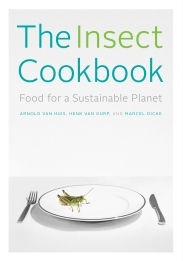 In my new book, I have a section on entomophagy, which is a big word that means eating insects. And entomophagy is a prominent part of my book trailer, if you haven’t had the joy (or stomach) to watch that yet. When I was researching the book, I requested a small stack of insect cookery books from my local library, which caused quite a stir behind the desk.
In my new book, I have a section on entomophagy, which is a big word that means eating insects. And entomophagy is a prominent part of my book trailer, if you haven’t had the joy (or stomach) to watch that yet. When I was researching the book, I requested a small stack of insect cookery books from my local library, which caused quite a stir behind the desk.
Now there’s a new book out called The Insect Cookbook: Food for a Sustainable Planet, and it’s a book that’s both why and how to eat insects. Initially published in the Netherlands (Het Insectenkookboek), it’s written by two Dutch entomologists and a chef, includes interviews with chefs and world figures, and is chock a block with recipes and sumptuous photos. I just got my copy in the mail, and my kids have been poking suspiciously at their dinners ever since.
The premise of the book is that we must begin including insects on our menus, because they’re “a sustainable source of protein for humans and a necessary part of our future diet.” As it says in the introduction, in order to feed the 9 billion people who will probably populate the earth by 2050, we need to increase our production of animal proteins by 73 percent. And much of that will have to come from insects.
This is not a new concept. People today eat insects in countries all over the world. And they’ve been doing so for millions of years.
The ancient Greeks and Romans regularly ate insects. The Greeks chomped on toasted cicadas, whereas Romans favored softer beetle grubs.
Bugs are good for you–low in fat and high in protein. They are a much better source of protein environmentally than are cows and pigs. The book is filled with cool information and interesting anecdotes. In Australia, for example, some clever entrepreneurs cashed in on a locust plague by marketing the insects as “sky prawns.” (p 20) Emperor Hirohito of Japan’s favorite dish was rice with wasp larvae, cooked in sugar and soy sauce. If you’re wondering how wasp larvae are collected, the book explains that wasp hunters attract the wasps with a piece of meat to which they have attached a tiny white flag. When the wasp flies away with the meat, they run, climb, and scramble after it until it reaches its nest. Then they anesthetize the insects with smoke and harvest the larvae. (p 27)
Here’s an interview with one of the authors, at the Boston Globe.
So how about it? Would you eat a bug? In all honesty, I’m trying, really trying, Dear Reader, to approach eating bugs with an open mind. I’ve gotten to the point where I can at least eat one and not gag, but I’m not yet at a place where I feel I could, say, sautee up some grubs and mix them into my scrambled eggs.
If you want to see some brave high school kids sampling dry roasted crickets, click here.